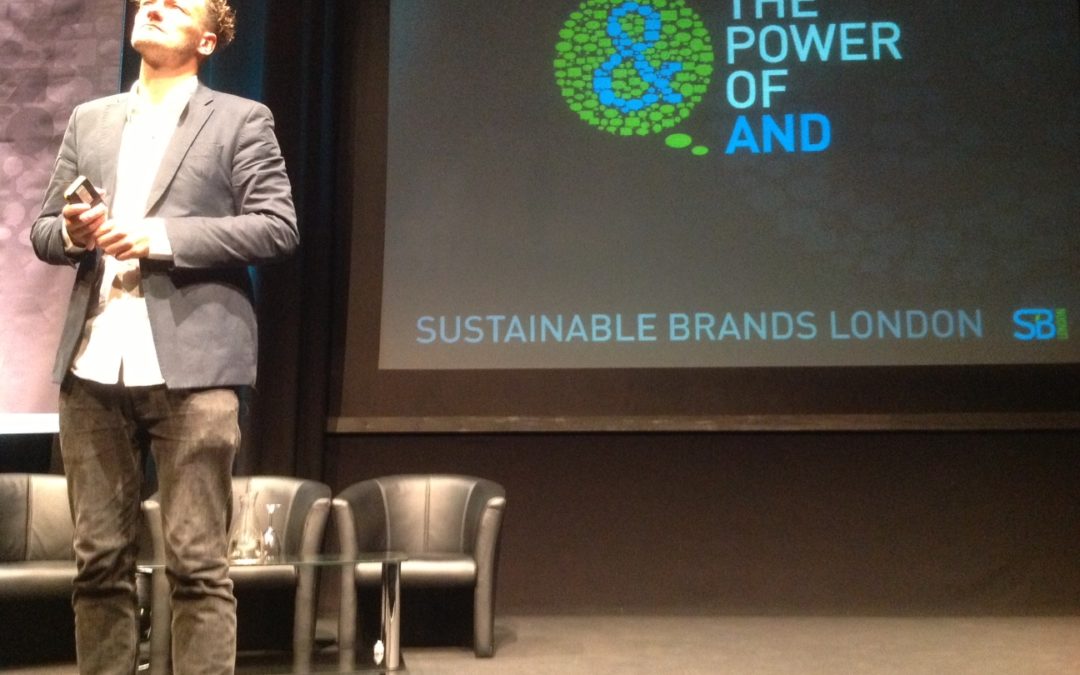Kick starting the Sustainable Brands Conference first cross-Atlantic passing from San Diego to London, author Paul Gilding expressed his dismay at the lack of real change when it comes to companies addressing pressing environmental and societal challenges. Comparing the preparation needed to address this problem with the allied soldiers during World War II doing push ups to get ready for battle with the Germans, Gilding made it clear that something serious needed to be done. The conference, which was attended by 500 leaders from companies such as Unilever, Nestle, eBay, Sainsbury and H&M aimed to help these companies, become better equipped to deal with the mounting crisis.
When I say sustainability you think of …
The conference didn’t leave much hope for those who don’t integrate sustainability into the heart of their brand and business. The MD Denis Darragh of Forbo, the flooring company, demonstrated that due to their well-integrated sustainability strategy they have a significant economic advantage over their competitors. Denis went on to argue that despite what people may think, sustainability costs less than not being sustainable. If sustainability isn’t associated with your brand like ketchup with Heinz you’re losing the competition. So in essence if a brand wishes to become a leading brand, they will have to own sustainability. Sustainability is a competitive imperative.
Sustainability is not a one man’s fight
Like in any other battle you stand a better chance if you work together. Based on the theme of the conference “The Power of &” as well as the common challenges facing brand owners, the answer seemed to be clear: collaborate. The theme of collaboration once again came through in the surprisingly honest and insightful experiences that the marketers shared with one another including; Philips, Sainbury’s and the telco 02. These companies discussed their shared approach to labeling their products in order to give consumers easy guidance when using their products while at the same time reducing the impact they have on the planet.
Fighting toxic chemicals and environmental loss together
H&M shared some of the initiatives they were working on in conjunction with Adidas and Nike to remove toxic chemicals from clothing. At the conference American Becker Underwood also shared how they have chosen to re-use Puma’s widely acknowledged environmental Profit and Loss Account. Despite their different approaches to business and their wide variety of products and services, these companies all share the same desire to find viable solutions that can meet the challenges of sustainability.
Design is the new green
There was also a lot of common ground when it came to the growing consumer interest in sustainability. The common question that emerged from this discussion was how do marketers close the gap between behavior and attitude when it comes to encouraging consumers to accept sustainability? The idea of Easy-Green was repeated throughout the conference as well as how sustainability increasingly takes the backseat to design and functionality when marketing products. One of the examples mentioned were method’s cleaning series that were the rare combination of minimalistic design and sustainability. The trend for sustainability seems to be moving away from the granola-eating-hippie messaging to the more sleek design and what’s-in-it-for-me prepositions, a move, which is much needed if brands want to win the heart and mind of the mainstream consumer.
Real visions, real impact
Some companies seem to be stepping up to the plate and doing more than small, incremental changes. Unilever’s Sustainable Living Plan shows a company dedicated to double growth while halving their environmental impact; a goal they not even sure is possible yet. Home improvement retailer Kingfisher (known for DIY’s like B&Q in the UK and Castorama in France) is also raising the bar with their Net Positive goals aimed at not only sourcing all their wood sustainably, but by 2050 even planting more trees than they use; leaving a positive impact on the environment.
A time for collaboration, a time for competition
For the many marketers sharing the challenges they are facing, I think they found comfort in knowing that they weren’t the only one’s struggling. But to truly champion the mounting crisis brands need to integrate sustainability in the heart of their brand and business. In that way they can turn risks into opportunities. That first step better be yours if you want to be on top of competition. There’s a time for collaboration – and a time for competition.

